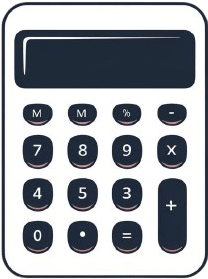Quick Guide: Convert Any Measurement in Seconds!
Select your measurement type from the tabs (Weight, Volume, Area, Length, or Temperature), then enter your value and choose your “from” and “to” units from the dropdown menus. Click “Convert” to see your result instantly, and check the “Show conversion formula” box to understand the math behind the conversion.
The Story of Measurement: Metric and Imperial Systems
Introduction
Throughout history, humans have needed standardized ways to measure their world. Two major systems emerged and continue to coexist: the metric system (now known as the International System of Units or SI) and the imperial system. Each has its own fascinating origin story and practical applications.
The Birth of the Metric System
The metric system emerged from the French Revolution, when scientists sought to create a rational, universal system of measurement. Unlike traditional units based on arbitrary standards, the metric system was designed to be based on natural phenomena.
The Meter: Our Basic Unit of Length
Originally, the meter was defined as one ten-millionth of the distance from the North Pole to the equator through Paris. While this definition has evolved with technology, this natural foundation made the meter truly universal. Today, it’s defined by the distance light travels in a vacuum in 1/299,792,458 of a second.
The Kilogram: From Weight to Mass
The kilogram was initially defined as the mass of one cubic decimeter (liter) of water at 4°C. This elegant connection between volume and mass made the system highly practical for both scientists and merchants. In 2019, it was redefined using the Planck constant, making it truly unchangeable.
The Celsius Scale: Water as Our Guide
Anders Celsius based his temperature scale on water’s freezing (0°C) and boiling points (100°C) at standard atmospheric pressure. This simple, logical system made temperature measurement more intuitive and reproducible.
The Imperial System’s Evolution
The imperial system grew organically from human experience and needs, rather than scientific principles. This explains both its quirks and its lasting appeal in some cultures.
Feet and Inches: Human-Scale Measurement
The foot, originally based on actual human feet, and the inch, derived from the width of a thumb, were inherently relatable to everyday human experience. This made them naturally intuitive for construction and crafts.
Pounds and Ounces: Commerce and Trade
The pound originated from the Roman “libra” (hence “lb”), while the ounce came from the Latin “uncia,” meaning one-twelfth. These units became deeply embedded in trade and commerce, explaining their persistence in markets and recipes.
Fahrenheit: A Different Approach to Temperature
Daniel Fahrenheit based his scale on three reference points: the coldest temperature he could reproduce (0°F), normal human body temperature (96°F, though later adjusted to 98.6°F), and water’s boiling point (212°F). While less mathematically elegant than Celsius, it offered finer gradation without negative numbers in most weather conditions.
The World’s Conversion to Metric
Most countries have adopted the metric system for its scientific precision and ease of calculation. The base-10 relationship between units (1 kilometer = 1000 meters, 1 kilogram = 1000 grams) makes conversions straightforward and reduces calculation errors.
Why Some Countries Retain Imperial Measures
The United States, Myanmar, and Liberia remain the only countries not fully converted to metric. The U.S. resistance stems from several factors:
- Historical momentum and cultural identity
- The enormous cost of converting infrastructure and industry
- The practical familiarity of imperial units in everyday life
- The embedded nature of imperial measurements in many industries, especially construction
Practical Applications Today
Many countries now use a hybrid approach:
- Construction: Still often uses imperial measurements in the U.S. due to standardized materials and existing infrastructure
- Science and Medicine: Exclusively metric worldwide for precision and standardization
- Cooking: Often uses both systems, with home cooks using traditional measures while commercial kitchens use metric
- International Trade: Predominantly metric, with special provisions for U.S. markets
Volume Measurements: A Special Case
Volume measurements show particular complexity because of their relationship to both weight and container size. The liter (1000 cubic centimeters) provides a clean connection to the metric system, while traditional measures like gallons and cups often relate better to practical usage in cooking and commerce.
Area Measurements: From Fields to Microscopes
Area measurements span enormous ranges, from microscopic (square millimeters) to geographic (square kilometers). The acre, still used in U.S. land measurement, originated as the area one person could plow in a day – another example of human-scale traditional measurement.
The Future of Measurement
While both systems continue to coexist, the trend toward metric is clear in scientific and international contexts. However, the persistence of imperial measurements in certain regions and applications reminds us that measurement systems must serve not just scientific precision, but also human usability and cultural continuity.
Common Unit Conversions For Everyday Situations
Length Conversions
- Feet to meters converter
- Inches to centimeters converter
- Meters to feet calculator
- Kilometers to miles converter
- Yards to meters converter
- Millimeters to inches calculator
- Miles to kilometers calculator
- Feet and inches to meters calculator
- How to convert feet into meters
- Calculate meters from feet
- Change inches to cm
- Metric to imperial length calculator
- Height converter feet to cm
- How many inches make a meter
- Convert height to metric
- Distance converter km to mi
- How many feet equals one meter
- Measure converter imperial to metric
Weight Conversions
- Pounds to kilograms converter
- Kilos to pounds calculator
- Ounces to grams converter
- Grams to ounces calculator
- Stones to kilograms converter
- Pounds and ounces to kilograms calculator
- Metric tons to pounds converter
- How much is 5kg in pounds
- Weight converter metric to imperial
- Convert my weight to kilos
- Change pounds to kg calculator
- How many grams in an ounce
- Body weight converter kg to lbs
- Recipe converter oz to g
- How many pounds make a kilogram
- Mass conversion calculator
- Convert cooking weights
Volume Conversions
- Liters to gallons converter
- Gallons to liters calculator
- Milliliters to fluid ounces converter
- Cups to milliliters calculator
- Quarts to liters converter
- US gallons to imperial gallons converter
- Fluid ounces to milliliters calculator
- How many ml in a cup
- Convert recipe measurements
- Liquid converter US to metric
- How much is a gallon in liters
- Kitchen conversion calculator
- Change ml to fl oz
- Cooking liquid converter
- How many cups in a liter
- Beverage volume converter
- Convert American cups to ml
Area Conversions
- Square feet to square meters converter
- Square meters to square feet calculator
- Acres to square meters converter
- Square kilometers to square miles calculator
- Square yards to square meters converter
- Hectares to acres converter
- Convert property size to metric
- How big is an acre in m2
- Land measurement converter
- Calculate floor area in square feet
- Room size converter
- Property size metric calculator
- How many square feet in a hectare
- Convert plot size
- Building area converter
- Calculate house size in metric
Temperature Conversions
- Fahrenheit to Celsius converter
- Celsius to Fahrenheit calculator
- Kelvin to Celsius converter
- Fahrenheit to Kelvin calculator
- Temperature conversion calculator
- What is X°F in Celsius
- Convert oven temperature
- Temperature scale converter
- Change weather forecast to Celsius
- Convert cooking temperature
- What temperature is freezing in F
- Room temperature converter
- Change thermostat settings
- Convert body temperature
- Weather unit converter
Real-World Unit Conversion Stories
“I Almost Ruined Christmas Dinner!” – A Temperature Tale
When my Australian friend shared her grandmother’s famous pavlova recipe, I was thrilled to try it. But there was just one problem – the recipe called for a 180°C oven, and my American kitchen only spoke Fahrenheit! After a quick conversion (180°C = 356°F), I rounded to 350°F and saved Christmas dessert from becoming a crispy disaster. Now I always keep a temperature converter handy for international recipes.
“The Gym Mystery That Had Everyone Confused” – A Weight Story During my first week at a new gym in London
I stood puzzled before a weight rack labeled in kilograms. My usual 30-pound dumbbell workout suddenly became a math problem! Turns out I needed to look for 14kg weights to maintain my routine (30 lbs = 13.6 kg). Who knew a simple weight conversion would be the key to maintaining my fitness routine abroad?
“The IKEA Furniture Fiasco” – A Length Learning Experience
Picture this: I’m trying to fit a European cabinet into my American apartment, armed only with a measuring tape and determination. The IKEA description said 2 meters tall, but my ceiling height was measured in feet. After converting (2m = 6.56 ft), I discovered I had just inches to spare! Since then, I’ve learned to convert measurements before leaving the store, not in my cramped elevator with a giant box.
“Pool Party Panic!” – A Volume Victory
When the pool maintenance guy told me I needed 3.8 liters of chlorine, I stared at my gallon jug in confusion. Thank goodness for unit converters – I quickly learned that 3.8 liters is almost exactly 1 gallon (3.8L = 1 gal). What could have been a pool chemistry disaster turned into a perfectly balanced summer splash!
“The Real Estate Reality Check” – An Area Adventure
House hunting internationally became quite the adventure when I discovered my 2000-square-foot dream home requirements needed translation. My European real estate agent needed that in square meters! After converting (2000 ft² = 185.8 m²), I finally could communicate my needs clearly. Who knew finding a home would require not just a budget calculator, but a unit converter too?
These everyday stories show how simple unit conversions can make the difference between success and chaos in our increasingly connected world. Whether you’re baking an international recipe, working out abroad, furniture shopping, maintaining a pool, or house hunting, understanding unit conversions is an essential life skill!
FAQs About Unit Conversions
Q: Why are there two different ton measurements?
A: There are actually three types of tons: the metric ton (1000 kg), the long ton (2240 lbs, used in the UK), and the short ton (2000 lbs, used in the US). These different measurements evolved from different trading systems and regional preferences throughout history.
Q: Why do the US and UK spell some units differently (e.g., meter/metre, liter/litre)?
A: This is due to historical language differences. The US adopted simplified spelling reforms in the early 1900s, while the UK maintained traditional British spelling. Both spellings are correct; they just reflect regional preferences.
Q: Why does the US use Fahrenheit while most countries use Celsius?
A: The US continues to use Fahrenheit largely due to historical momentum and the costs associated with changing an entire nation’s temperature measuring systems. Fahrenheit was the standard when the US was developing as a nation, and it has persisted despite global adoption of Celsius.
Q: How do I convert recipe measurements between US and UK systems?
A: This can be tricky because not only are the units different, but US and UK cups and pints are different sizes! A US cup is 236.588 mL, while a UK cup is 284.131 mL. Always check which system your recipe uses, and when in doubt, use metric measurements for precision.
Q: Why is water used as a reference point for many measurements?
A: Water is used because it’s universal, easily accessible, and has useful properties. For example, in the metric system, 1 liter of water weighs 1 kilogram and freezes at 0°C. These relationships make water an excellent reference point for establishing measurement standards.
Q: How can I quickly estimate conversions without a calculator?
A: Here are some helpful approximations:
- 1 kilogram ≈ 2.2 pounds
- 1 inch ≈ 2.54 centimeters
- 1 mile ≈ 1.6 kilometers
- 1 liter ≈ 1.06 quarts
- Room temperature: 20°C ≈ 68°F
Q: Why do scientists prefer the metric system?
A: Scientists prefer metric because it’s based on decimals (making calculations easier), it’s universally standardized, and it has logical relationships between different types of measurements. For example, 1 cubic centimeter of water equals 1 milliliter and weighs 1 gram.
Q: When should I use square meters vs. hectares?
A: Use square meters (m²) for smaller areas like rooms or small plots. Use hectares (ha) for larger areas like farms or parks – one hectare equals 10,000 square meters. For perspective, a typical soccer field is about 0.7 hectares or 7,000 square meters.
Q: How can I visualize metric measurements in everyday terms?
A: Here are some practical references:
- 1 meter is slightly longer than a yard stick
- 1 kilogram is about the weight of a standard pineapple
- 1 liter is slightly more than a quart of milk
- 1 kilometer is about 6 city blocks
- 1 centimeter is about the width of your fingernail
Q: Why doesn’t the US fully convert to the metric system?
A: The main obstacles are cost and cultural inertia. Converting road signs, construction standards, manufacturing equipment, and educational materials would be extremely expensive. Plus, many Americans are comfortable with customary units and use them in daily life, making change difficult despite the metric system’s advantages.








Leave a Reply